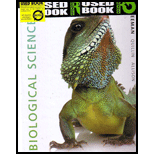
Concept explainers
Which statement about the daughter cells following mitosis and cytokinesis is correct?
a. They are genetically different from each other and from the parent cell.
b. They are genetically identical to each other and to the parent cell.
c. They are genetically identical to each other but different from the parent cell.
d. Only one of the two daughter cells is genetically identical to the parent cell.
Introduction:
Mitosis and cytokinesis are the processes of cell division, where parental chromosome replicates and produces homologous chromosomes that are equally divided into two daughter cells.
Answer to Problem 1TYK
Correct answer:
The daughter cells are genetically identical to each other and to the parent cell after mitosis and cytokinesis.
Explanation of Solution
Explanation/Justification for the correct answer:
Option (b) is given that the daughter cells are genetically identical to each other and to the parent cell. Mitosis is a type of cell division. During mitosis, the genetic material of the parent cell is replicated or copied. This replication is followed by the division of the genetic material; that is, the nucleus divides into two parts.
The process of cytokinesis or the division of cytoplasm follows the mitosis process. In this process, the parent cell’s cytoplasm divides and two daughter cells are formed. The mitotic division is also known as cellular replication because the daughter cells are exact copies of the parent cell and are identical to each other as well. Hence, option (b) is correct.
Explanation for incorrect answers:
Option (a) is given that the daughter cells are genetically different from each other and from the parent cell. The mitosis is the process of replication of the chromosomes of the parent cell and its division into two daughter cells. The cytoplasm divides equally into two daughter cells after mitosis by the process of cytokinesis. So, it is a wrong answer.
Option (c) is given that the daughter cells are genetically identical to each other, but different from the parent cell. The process of mitosis and cytokinesis divides the genetic material as well as the cytoplasm of the parent cell into two daughter cells. Thus, the daughter cells are identical to each other and to the parent cell also. So, it is a wrong answer.
Option (d) is given that only one of the two daughter cells are genetically identical to the parent cell. The mitosis followed by cytokinesis divides the genetic material as well as the cytoplasm of the parent cell into two daughter cells. Therefore, the daughter cells are genetically identical to each other and to the parent cell also. So, it is a wrong answer.
Hence, options (a), (c), and (d) are incorrect.
After mitosis and cytokinesis, the two replicated copies of the genetic material formed from the parent cell during mitosis get equally divided into two daughter cells.
Want to see more full solutions like this?
Chapter 12 Solutions
Biological Science
- Not part of a graded assignment, from a past midtermarrow_forwardNoggin mutation: The mouse, one of the phenotypic consequences of Noggin mutationis mispatterning of the spinal cord, in the posterior region of the mouse embryo, suchthat in the hindlimb region the more ventral fates are lost, and the dorsal Pax3 domain isexpanded. (this experiment is not in the lectures).a. Hypothesis for why: What would be your hypothesis for why the ventral fatesare lost and dorsal fates expanded? Include in your answer the words notochord,BMP, SHH and either (or both of) surface ectoderm or lateral plate mesodermarrow_forwardNot part of a graded assignment, from a past midtermarrow_forward
- Explain in a flowcharts organazing the words down below: genetics Chromosomes Inheritance DNA & Genes Mutations Proteinsarrow_forwardplease helparrow_forwardWhat does the heavy dark line along collecting duct tell us about water reabsorption in this individual at this time? What does the heavy dark line along collecting duct tell us about ADH secretion in this individual at this time?arrow_forward
 Concepts of BiologyBiologyISBN:9781938168116Author:Samantha Fowler, Rebecca Roush, James WisePublisher:OpenStax College
Concepts of BiologyBiologyISBN:9781938168116Author:Samantha Fowler, Rebecca Roush, James WisePublisher:OpenStax College Human Biology (MindTap Course List)BiologyISBN:9781305112100Author:Cecie Starr, Beverly McMillanPublisher:Cengage Learning
Human Biology (MindTap Course List)BiologyISBN:9781305112100Author:Cecie Starr, Beverly McMillanPublisher:Cengage Learning
 Human Heredity: Principles and Issues (MindTap Co...BiologyISBN:9781305251052Author:Michael CummingsPublisher:Cengage Learning
Human Heredity: Principles and Issues (MindTap Co...BiologyISBN:9781305251052Author:Michael CummingsPublisher:Cengage Learning Biology (MindTap Course List)BiologyISBN:9781337392938Author:Eldra Solomon, Charles Martin, Diana W. Martin, Linda R. BergPublisher:Cengage Learning
Biology (MindTap Course List)BiologyISBN:9781337392938Author:Eldra Solomon, Charles Martin, Diana W. Martin, Linda R. BergPublisher:Cengage Learning Anatomy & PhysiologyBiologyISBN:9781938168130Author:Kelly A. Young, James A. Wise, Peter DeSaix, Dean H. Kruse, Brandon Poe, Eddie Johnson, Jody E. Johnson, Oksana Korol, J. Gordon Betts, Mark WomblePublisher:OpenStax College
Anatomy & PhysiologyBiologyISBN:9781938168130Author:Kelly A. Young, James A. Wise, Peter DeSaix, Dean H. Kruse, Brandon Poe, Eddie Johnson, Jody E. Johnson, Oksana Korol, J. Gordon Betts, Mark WomblePublisher:OpenStax College





